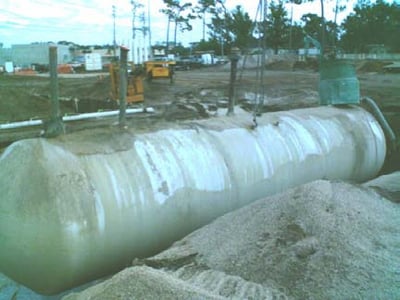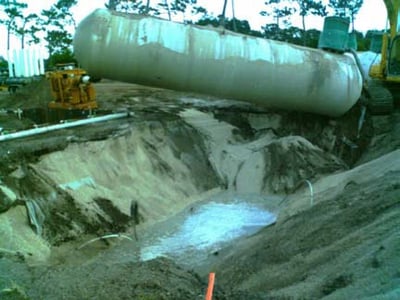 |
 |
We performed an underground storage tank (UST) system closure assessment involving the removal of three 12,000-gallon USTs containing unleaded gasoline. The site operated as an Exxon-branded convenience store and retail petroleum facility. The investigation was conducted to evaluate soil and groundwater quality with respect to petroleum hydrocarbons for the removal of the UST system.
Prior to the UST system removal, we performed ten soil borings along the product lines and four soil borings around the USTs. Soil was collected at two-foot intervals into the vadose zone and subsequently screened with a calibrated Flame Ionization Detector (FID). During the excavation and removal of the UST system, we performed soil screening with a calibrated FID. The results of the soil screening from both events did not indicate the presence of petroleum hydrocarbon vapors in soil above background levels. Soil samples submitted for laboratory analysis reported no detection of the target compounds above applicable Soil Cleanup Target Levels (SCTLs).
In addition to the soil screening and laboratory analyses, four temporary monitoring wells (TW-11, TW-12, TW-13, and TW-14) were installed to assess groundwater quality in the vicinity of the UST system. Groundwater sampling results reported benzene and MTBE to be above Groundwater Cleanup Target Levels (GCTLs). We performed subsequent site assessment including the installation of four monitoring wells (MW-1 through MW-4) via direct push method to a total depth of 13 feet below land surface (BLS).
During the monitoring well installation activities, HCR personnel collected soil samples at regular intervals to one foot below the water table. Subsequently, the soil samples were screened with an FID. The results of soil screening activities ranged from below detection levels [<1 part per million (ppm)] to 20 ppm from soil samples collected above the water table.
We collected groundwater samples from MW-1 through MW-4. The groundwater samples reported dissolved petroleum hydrocarbons to be below detection levels and/or below GCTLs. HCR conducted follow-up natural attenuation monitoring in 2005 and 2006 and successfully achieved a Site Rehabilitation Complete Order (SRCO). Upon receipt of the SRCO the monitoring wells were abandoned.

The first step to completing any project is getting started. Request a free consultation today with one of our specialists to help evaluate your environmental needs, have any of your questions answered and get on the path to identifying an appropriate solution.
Handex Consulting & Remediation, LLC
2211 Lee Road, Suite 110
Winter Park, FL 32789
Phone: (321) 441-9801
Fax: (321) 594-2710
Email Us